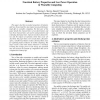Free Online Productivity Tools
i2Speak
i2Symbol
i2OCR
iTex2Img
iWeb2Print
iWeb2Shot
i2Type
iPdf2Split
iPdf2Merge
i2Bopomofo
i2Arabic
i2Style
i2Image
i2PDF
iLatex2Rtf
Sci2ools
ISWC
1999
IEEE
1999
IEEE
Non-Ideal Battery Properties and Low Power Operation in Wearable Computing
This paper describes non-ideal properties of batteries and how these properties may impact power-performance trade-offs in wearable computing. The first part of the paper details the characteristics of an ideal battery and how these characteristics are used in sizing batteries and estimating discharge times. Typical non-ideal characteristics and the regions of operation where they occur are described. The paper then covers results from a first-principles, variable-load battery model, showing likely areas for exploiting battery behavior in mobile computing. The major result is that when battery behavior is non-ideal, lowering the average power or the energy per operation may not increase the amount of computation that can be completed in a battery life.
Battery Behavior | Human Computer Interaction | ISWC 1999 | Non-ideal Properties | Typical Non-ideal Characteristics |
| Added | 04 Aug 2010 |
| Updated | 04 Aug 2010 |
| Type | Conference |
| Year | 1999 |
| Where | ISWC |
| Authors | Thomas L. Martin, Daniel P. Siewiorek |
Comments (0)

